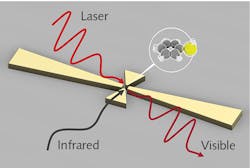Frequency-upconversion scheme for detection of LWIR light has single-photon sensitivity
Detection of midwave- and longwave-infrared (MWIR and LWIR) radiation normally requires complex and costly equipment. The most popular technique is the use of bolometers—arrays of small thermometers measuring the heat produced by radiation absorption. They have many limitations, in particular their slow response and inability to detect very low levels of radiation (with the extreme example being a single photon). A novel approach proposed by researchers at the Swiss Federal Institute of Technology (EPFL; Lausanne, Switzerland) and the Max Planck Institute for the Science of Light (Erlangen, Germany) follows a completely different route: first convert the IR radiation into visible light, and then detect it with existing technologies.
At the core of the new concept lies an array of hybrid metal-molecule nanostructures. In each nanostructure, the geometry of a dual resonant metal nanoantenna is tailored to focus IR radiation (in the form of plasmons) on the molecular oscillators, which lie at the center of the nanoantenna and are brought into vibration by the IR light. In addition, the nanoantenna is pumped with a low level of light from a short-wavelength laser; the incoming IR radiation and the pump laser radiation are each resonant with a different component of the antenna, which is arranged in a crossed configuration. The energy of the vibrating molecules at the center of the antenna is then converted again into radiation, but this time at a much higher frequency, in the visible domain. The hybrid nanostructure allows for high conversion efficiency while reducing the size of the device to dimensions significantly smaller than the wavelength of the IR light.
The proposed molecular oscillator is thiophenol (C6H5SH), a common small organic molecule. One version of the dual nanoantenna is about 175 nm from end to end with a central gap of on the order of 20 nm. This geometry can receive radiation at a 9.4 μm wavelength and convert it to light at an 801 nm wavelength; the researchers say that single IR photons should be detectable in this way. “The low level of noise added by the molecular vibration during the conversion process enables the detection of extremely weak signals at room temperature,” says Philippe Roelli, one of the researchers. “With advanced devices, we anticipate to reach quantum-limited conversion and have the unique opportunity to resolve the signal of single quanta of infrared light.” Reference: P. Roelli et al., Phys. Rev. X (2020); https://doi.org/10.1103/physrevx.10.031057.
About the Author
John Wallace
Senior Technical Editor (1998-2022)
John Wallace was with Laser Focus World for nearly 25 years, retiring in late June 2022. He obtained a bachelor's degree in mechanical engineering and physics at Rutgers University and a master's in optical engineering at the University of Rochester. Before becoming an editor, John worked as an engineer at RCA, Exxon, Eastman Kodak, and GCA Corporation.

